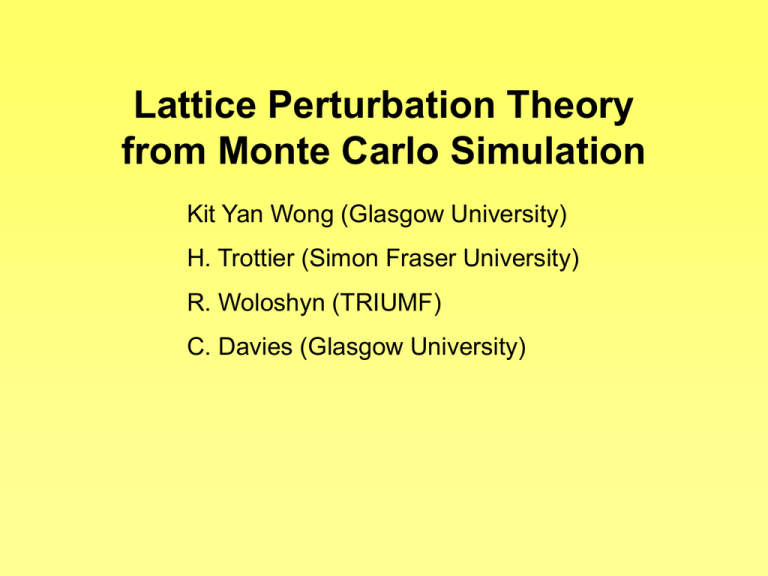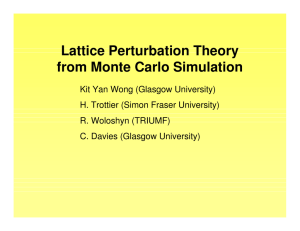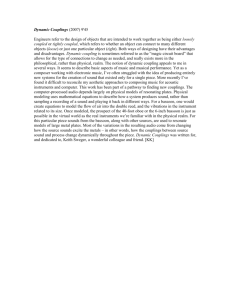Lattice Perturbation Theory from Monte Carlo Simulation
advertisement

Lattice Perturbation Theory from Monte Carlo Simulation Kit Yan Wong (Glasgow University) H. Trottier (Simon Fraser University) R. Woloshyn (TRIUMF) C. Davies (Glasgow University) Motivation: we need perturbation theory example 1. determination of s [Q. Mason et al., PRL95, 052002 (2005)] MS ( M Z ) 0.1170(12) world average: 0.11870.002 WR ,T c1V (qR* ,T / a) c2V2 (qR* ,T / a) ... measure this in simulation convert V (qR* ,T / a) solve for V (qR ,T / a) * to MS M Z need c1, c2, … 0.115 0.117 0.119 MS ( M Z ) 1/15 Motivation: we need perturbation theory example 2. quark masses [Q. Mason et al., hep-ph/0511160] [M. Nobes & H. Trottier, hep-lat/0509128] (MeV) M MS (2GeV ) 10000 b c 1000 s 100 10 d u need connection between bare mass and MS mass lattice PDG 1 2/15 Lattice PT is Difficult! particularly true for highly improved actions and higher-order calculations some of the 2-loop diagrams in the expansion for a Wilson loop: X X X X X X X X X X X XX XX X taken from Q. Mason’s Ph.D Thesis (Cornell Electronic Library) 3/15 so … we need another method Monte Carlo Simulations at Weak Couplings 4/15 Weak Coupling Simulations 1. do several simulations at weak couplings weak couplings perturbative phase weak couplings? b ~ 9.5-80.0 (s ~ 0.1-0.01) 2. fit the data points with an expansion in s 5/15 Weak Coupling Simulations lnW2, 2 / V example 1. 9 simulations at weak couplings 9 data points (V,-lnWR,T) 1.16 c1: intercept 1.14 W2,2 1.12 1.1 2. fit the points to lnWR ,T 1.08 V 1.06 c1 c2V c3 ... 2 V c2: slope c3: curvature 0 0.03 0.06 0.09 0.12 0.15 V (q2*, 2 ) 6/15 Weak Coupling Simulations many calculations have been done before: Dimm, Lepage & Mackenzie [Nucl. Phys. B (Proc. Suppl.), 42, 403 (1995)] 1st-order mass renormalization for Wilson fermions Trottier, Shakespeare, Lepage & Mackenzie [PRD, 65, 094502 (2002)] 3rd-order Wilson loops for the Wilson plaquette action Hart, Horgan & Storoni [PRD, 70, 034501 (2004)] tadpole factor in pure gauge theories quenched calculations here: unquenched (MILC) important cross-check of the 2-loop expansions used in the s calculation 7/15 Difficulties need very accurate measurements: statistical errors ~ 10-5 – 10-6 ~ s3 why? want to probe the 3rd-order coefficients challenge: tight control of systematic errors, both in simulations and analysis tunneling between Z3 center phases fitting and truncation errors zero momentum modes step size errors in simulation equations autocorrelation inaccuracy in matrix inversions 8/15 Simulation Parameters MILC action, 9 couplings b 0 V (q1*,1 ) 9.5 0.0838 0.1278 11.0 0.0723 0.1016 13.5 0.0589 0.0741 16.0 0.0497 0.0619 19.0 0.0419 0.0506 24.0 0.0332 0.0382 32.0 0.0249 0.0271 47.0 0.0169 0.0183 80.0 0.0099 0.0101 input from analytic PT 0 V (q1*,1 ) (not necessary) use 2-loop expansion of the plaquette 9/15 Results Perturbation Theory Monte Carlo Simulation Loop c1 c2 c3 1x2 0.9252(0) -0.646(9) 0.23(5) 0.9251(3) -0.644(13) 0.20(18) 1x3 0.9845(0) -0.595(1) 0.38(6) 0.9845(3) -0.599(14) 0.37(19) 2x2 1.1499(0) -0.643(2) 0.59(9) 1.1499(4) -0.641(15) 0.58(20) 2x3 1.2341(0) -0.595(3) 0.85(16) 1.2342(4) -0.599(19) 0.88(26) Fit with c1 fixed to PT values c1 c2 c3 Both c1, c2 fixed Loop c2 c3 Loop c3 1x2 -0.649(5) 0.26(12) 1x2 0.21(4) 1x3 -0.600(6) 0.39(13) 1x3 0.28(5) 2x2 -0.642(7) 0.59(14) 2x2 0.61(6) 2x3 -0.594(7) 0.82(15) 2x3 0.84(8) 10/15 Results – 2x2 Loop k1 k2 1.16 -0.54 1.14 -0.58 1.12 -0.62 1.1 -0.66 1.08 1.06 -0.7 0 k3 0.03 0.06 0.09 0.12 2 0.15 V (q2*, 2 ) k1 = 1.5 1 0.5 k2 = 0 -0.5 k3 = -1 0 0.03 0.06 0.09 0.12 0 0.03 lnW2, 2 V 0.06 0.09 0.12 0.15 V (q2*, 2 ) c1 c2V ... lnW2, 2 c1V V c2 c3V ... lnW2, 2 c1V c2V2 V c3 ... 0.15 V (q2*, 2 ) 11/15 provides an important cross-check of the 2-loop expansions used in the s calculation 12/15 Results – NRQCD NRQCD action: 2 H ; 2M 0 dispersion E0 c1V ( qE* ) c2V2 ( qE* ) ... zero energy: mass renormalization: M 2.44 E0 /V 2.42 * * M 0 1 c1V ( qM ) c2V2 ( qM ) ... zero energy c1: intercept aM0 = 8.0 0.9 2.4 0.86 2.38 2.36 2.34 2.32 0.84 c2: slope c3: curvature 0.82 2.3 0 0.02 0.04 V(q E*) 0.06 0.08 mass renormalization aM0 = 8.0 0.88 (M/M0 -1)/ V 2.46 p2 relation E E0 2M 0.8 0 c1: intercept c2: slope c3: curvature 0.02 0.04 V(q M*) 0.06 0.08 13/15 Results – NRQCD c1: zero energy mass renormalization M0 a PT MC M0 a PT MC 8.0 2.450 2.447(2) 8.0 0.850 0.867(6) 6.0 2.570 2.565(5) 6.0 0.830 0.849(7) 5.0 2.655 2.648(5) 5.0 0.820 0.842(9) 4.0 2.782 2.773(7) 4.0 0.770 0.798(10) Predictions for c2 and c3: M0 a c2 c3 M0 a c2 c3 8.0 -1.98(8) 5.9(1.4) 8.0 -0.34(37) -0.2(4.9) 6.0 -1.91(7) 6.3(1.4) 6.0 -0.33(42) 0.5(5.3) 5.0 -2.02(7) 7.3(1.4) 5.0 -0.53(45) 0.7(6.1) 4.0 -2.13(7) 7.4(1.4) 4.0 -0.91(56) -0.28(6.7) 14/15 Conclusions 1. numerical approach is simple; give accurate results 2. Wilson loops: impressive agreement important for the s calculation 3. in progress: HIST, mNRQCD 15/15


![M340/101 Fall 1997 [40%] 1. Use the two-phase method to solve maximize](http://s2.studylib.net/store/data/011171260_1-8fb413b1b78c6de56b99ec6d2d944a38-300x300.png)

